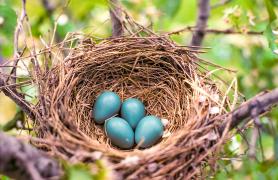Body
- A bobolink perched atop a compass plant proclaims with twangy tweets that this patch of prairie belongs to him — at least for now. When nesting season ends, he and his family will point their beaks south and fly to South America for the winter.
- Most katydids are green, which helps them hide on plants. Pink katydids stick out like bubblegum on a bedpost, and this one just got spotted! A scissor-tailed flycatcher uses its forked tail to turn like a feathered fighter jet. If the katydid doesn’t take evasive action, it will soon be bird chow.
- A northern harrier thinks it has plucked a snake from the prairie floor. But as the hawk lifts off, the serpent breaks into two wiggly pieces. Squawk! Startled, the harrier drops its dinner.
- These bumblebees are buzzy — oops, busy — gathering groceries. After collecting pollen and nectar, the workers zip back to their underground nest. There, they’ll share the food with their homebound queen and her babies.
- A mama coyote prowls the prairie, hunting prey to carry home for her hungry pups. Not only are these canines crafty, they’re also doggone fast! Coyotes can sprint 40 miles an hour for short distances, which is plenty quick enough to run down a rabbit.
- A compass plant’s lower leaves grow with their edges pointing north and south. This way, less of the leaf is facing the hot, moisture-stealing sun.
- Goodness sake, that’s no snake! It’s a glass lizard. Even though this lizard lacks legs, it has eyelids and ear holes, which snakes don’t have. When attacked, glass lizards shed their tails. The tail squirms, giving the lizard time to wiggle away.
- While mama prairie chicken keeps an eye out for predators, her youngsters chase insects to eat. In the spring, male chickens dance to attract a mate. They fan out their tails, stamp their feet, and make booming noises that can be heard a mile away.
- Unlike the grass in your yard, prairie grasses grow in clumps. The bare ground in between makes it easy for animals like chickens to move around.
- Nom, nom, nom. An ornate box turtle has found blackberries for breakfast. Although insects make up most of the turtle’s diet, it also eats tender shoots and fruits.
- Prairie mole crickets spend most of their lives underground, except during spring. That’s when females fly around to look for mates. Males can’t fly. Their wings are made to sing. They rub them together to make chirping sounds that drive lady crickets crazy. To make their love chirps louder, males dig trumpet-shaped tunnels.
- Prairie plants sink deep roots to find water. Big bluestem roots may reach 8 feet, and compass plant roots may reach 15 feet.
- Crayfish need water, but not all crayfish live in streams. Some, like this grassland crayfish, burrow down to find water underground. It isn’t unusual for their tunnels to run more than 15 feet deep. As they excavate, they carry blobs of mud in their pincers, stacking it at the surface to form tiny chimneys.
- Why dig when you can borrow a burrow? Northern crawfish frogs make their homes in crayfish and mammal burrows. During the day, they hide underground. At night they emerge to snag insects and spiders. If you hear snoring, the frog isn’t sleeping. It’s calling to attract a mate.
- Armed with strong legs, wide paws, and long claws, badgers are the fastest diggers on the prairie. They have to be to catch burrowing mammals like ground squirrels. Digging fast also helps badgers disappear underground to escape enemies. You dig?
- This Franklin’s ground squirrel better skedaddle! A hungry bullsnake is hot on its tail. Missouri’s largest snake can grow more than 6 feet long — plenty big enough to put the squeeze on a squirrel. But fear not for the furry one. Ground squirrels dig a maze of burrows, including several escape tunnels.
- June 2 is National Prairie Day. Celebrate by exploring one of Missouri’s amazing grasslands. No matter which one you choose, you’ll find it abloom with riots of purple, pink, and yellow wildflowers. Go in the early evening when it’s cooler and you don’t have to deal with morning dew. To find a prairie, visit mdc.mo.gov/atlas or moprairie.org.
Image

Credit
David Besenger
Right to Use
Image

Credit
David Besenger
Right to Use
Image

Credit
David Besenger
Right to Use
Image

Credit
David Besenger
Right to Use
Image

Image

Image

Image

Also In This Issue
Media

Body
Check out the many ways and out of the way places birds build their nests.
And More...
This Issue's Staff
Bonnie Chasteen
Les Fortenberry
Karen Hudson
Angie Daly Morfeld
Noppadol Paothong
Marci Porter
Mark Raithel
Laura Scheuler
Matt Seek
David Stonner
Nichole LeClair Terrill
Stephanie Thurber
Cliff White
Les Fortenberry
Karen Hudson
Angie Daly Morfeld
Noppadol Paothong
Marci Porter
Mark Raithel
Laura Scheuler
Matt Seek
David Stonner
Nichole LeClair Terrill
Stephanie Thurber
Cliff White






















